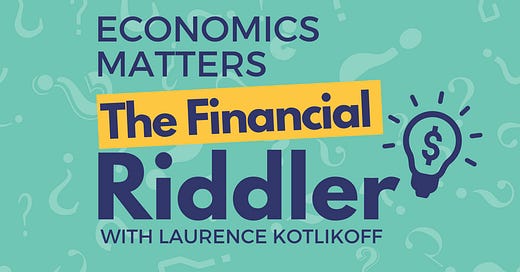How many people received Social Security claw back letters last year — many for tens of thousands of dollars, with no explanation let along proof of the alleged overpayment?
a. 250,000
b. 500,000
c. 1,000,000
d. 2,000,000
And the answer is …
The answer is 2 million! David Hilzenrath and Jodie Fleischer who write for KFF Health News and broke the story of Social Security’s clawbacks this summer (Well, I started writing about it a decade ago, buy to precious little attention.), scooping 60 Minutes (second segment), did what everyone needs to do when they hear Social Security say something in writing or publicly — Don’t believe it. They used the Freedom of Information Act to check on the Acting Commissioner, Dr. Kilolo Kijakazi’s, recent testimony. She may have misread the doc she was handed when asked by House Subcommittee on Social Security member, Congressman Mike Carey, how many people had received clawback letters in the last two years. Her answer was roughly 1 million in each year. Hilzenrath and Fleischer discovered that the true number, including Supplemental Security Income recipients, is 2 million per year. In my just-released book with Terry Savage — Social Security Horror Stories (PLEASE, FOR GOSH SAKES, READ THIS BOOK TO PROTECT YOURSELF!), we reported that clawbacks totaled less than 250,000 annually. Who gave us that bogus number? Social Security, of course. In this case, it was the Chicago headquaters.
What is the labor force participation rate of Japanese age 65-69?
a. 47%
b. 37%
c. 27%
d. 17%
e. 7%
And the answer is …
The answer is 47%. According to a 2021 Japanese government report, “… 71.0% of people aged 60 to 64 were in employment in 2020. This ratio was 49.6% for people aged 65–69 and 32.5% for those aged 70–74. Compared to 10 years ago, all these rates have increased by more than 10 points.” The U.S. rate for those 65-74 is 31.4%. That’s up from 25.5 percent in 2002. The bottom line? The Japanese and, increasingly Americans, are working longer in response to the aging of their countries.
What share of the Japanese population is age 65 or older?
a. 12.9 percent
b. 15.8 percent
c. 23.7 percent
d. 29.1 percent
e. 34.1 percent
And the answer is …
A total of 29.1% of the Japanese population is 65 or older, making it the oldest country on the planet! The U.S. figure is 17.3%.
Nominal wages are growing at roughly
a. 6.5%
b. 5.5%
c. 4.5%
d. 3.5%
e. 2.5%
f. 1.5%
And the answer is …
The answer, according to Torsten Slok, Apollo’s Chief Economist, is 4.5 percent. That’s a lot higher than the Fed’s 2% inflation target. Core inflation, between last October and October 2022 was 4%. Hence, real wages are rising, but very slowly.
How much in absolute terms have average real hourly wages of production and non-supervisory workers increased since 1965?
a. -$3.19
b. -99 cents
c. 17 cents
d. $7.14
e. $12.41
And the answer is …
The answer is 17 cents! This has to be the worst stat period about the postwar U.S. economy. But other stats paint a very different pic. Real per capita U.S. GDP has risen by a factor of three since 1965. There’s are several, interconnected explanations here. One is an increase in wage inequality. Another is a decline, of late, in labor’s share of output. A third is a widening gap between labor productivity and real wages. The growth of wage inequality is, it seems, the really big deal. According to this study, “From 1979 to 2019, wages for the lowest wage workers—measured by the tenth percentile wage—barely budged, rising just 3 percent after inflation. … From 1979 to 2019, the wages of the top 1 percent rose by 160 percent after inflation, while wages rose 345 percent for the highest 0.1 percent of earners.” The good news, and there is some, is that the lowest paid workers are seeing faster wage growth of late than middle-wage workers and that overall average hourly real wage growth has been substantial since 1990. Incredibly, real average hourly wages fell by roughly 15 percent between 1973 and 1995.
Is low fertility worse than wage inequality in raising Social Security’s long-term unfunded liability?
a. Worse
b. Better
And the answer is …
The answer, as explained by Steve Goss, Social Security’s outstanding Chief Actuary, is better. Wage inequality, specifically the fact that since the Greenspan Commission “fixed” Social Security’s finances in 1983, wages of the top 6 percent of earners above the ceiling grew by 62 percent. For the 96 percent below the ceiling, the growth rate was only 17 percent.
What share of the world’s new power capacity installed last year represented renewables?
a. One tenth
b. One fifth
c. Two fifths
d. Three fifths
e. Four fifths
And the answer is …
The answer is four fifths.
Roughly what fraction of Americans either think that buying a single company’s stock usually provides a safer return than a stock mutual fund, aren’t sure, or won’t say?
a. 10 percent
b. 25 percent
c. 50 percent
d. 75 percent
e. 79 percent
The answer is 50 percent with women able to get this right significantly less often than men. This is a pretty damning statement about the state of Americans’ financial literacy.




